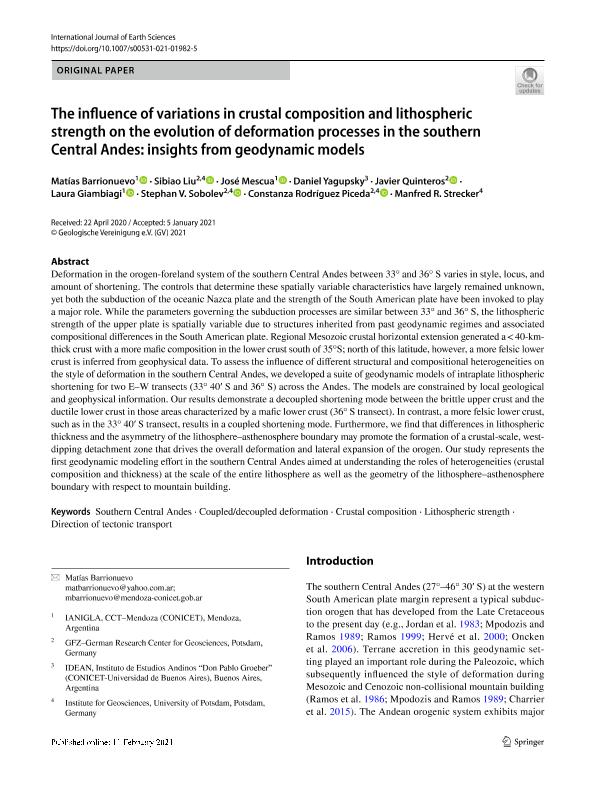Mostrar el registro sencillo del ítem
dc.contributor.author
Barrionuevo, Matías

dc.contributor.author
Liu, Sibiao
dc.contributor.author
Mescua, Jose Francisco

dc.contributor.author
Yagupsky, Daniel Leonardo

dc.contributor.author
Quinteros, Javier
dc.contributor.author
Giambiagi, Laura Beatriz

dc.contributor.author
Sobolev, Stephan V.
dc.contributor.author
Piceda, Constanza Rodríguez
dc.contributor.author
Strecker, Manfred R.
dc.date.available
2021-07-08T18:37:11Z
dc.date.issued
2021-02
dc.identifier.citation
Barrionuevo, Matías; Liu, Sibiao; Mescua, Jose Francisco; Yagupsky, Daniel Leonardo; Quinteros, Javier; et al.; The influence of variations in crustal composition and lithospheric strength on the evolution of deformation processes in the southern Central Andes: insights from geodynamic models; Springer; International Journal of Earth Sciences; 2-2021; 1-24
dc.identifier.issn
1437-3254
dc.identifier.uri
http://hdl.handle.net/11336/135747
dc.description.abstract
Deformation in the orogen-foreland system of the southern Central Andes between 33° and 36° S varies in style, locus, and amount of shortening. The controls that determine these spatially variable characteristics have largely remained unknown, yet both the subduction of the oceanic Nazca plate and the strength of the South American plate have been invoked to play a major role. While the parameters governing the subduction processes are similar between 33° and 36° S, the lithospheric strength of the upper plate is spatially variable due to structures inherited from past geodynamic regimes and associated compositional differences in the South American plate. Regional Mesozoic crustal horizontal extension generated a < 40-km-thick crust with a more mafic composition in the lower crust south of 35°S; north of this latitude, however, a more felsic lower crust is inferred from geophysical data. To assess the influence of different structural and compositional heterogeneities on the style of deformation in the southern Central Andes, we developed a suite of geodynamic models of intraplate lithospheric shortening for two E–W transects (33° 40′ S and 36° S) across the Andes. The models are constrained by local geological and geophysical information. Our results demonstrate a decoupled shortening mode between the brittle upper crust and the ductile lower crust in those areas characterized by a mafic lower crust (36° S transect). In contrast, a more felsic lower crust, such as in the 33° 40′ S transect, results in a coupled shortening mode. Furthermore, we find that differences in lithospheric thickness and the asymmetry of the lithosphere–asthenosphere boundary may promote the formation of a crustal-scale, west-dipping detachment zone that drives the overall deformation and lateral expansion of the orogen. Our study represents the first geodynamic modeling effort in the southern Central Andes aimed at understanding the roles of heterogeneities (crustal composition and thickness) at the scale of the entire lithosphere as well as the geometry of the lithosphere–asthenosphere boundary with respect to mountain building.
dc.format
application/pdf
dc.language.iso
eng
dc.publisher
Springer

dc.rights
info:eu-repo/semantics/openAccess
dc.rights.uri
https://creativecommons.org/licenses/by-nc-sa/2.5/ar/
dc.subject
COUPLED/DECOUPLED DEFORMATION
dc.subject
CRUSTAL COMPOSITION
dc.subject
DIRECTION OF TECTONIC TRANSPORT
dc.subject
LITHOSPHERIC STRENGTH
dc.subject
SOUTHERN CENTRAL ANDES
dc.subject.classification
Geología

dc.subject.classification
Ciencias de la Tierra y relacionadas con el Medio Ambiente

dc.subject.classification
CIENCIAS NATURALES Y EXACTAS

dc.title
The influence of variations in crustal composition and lithospheric strength on the evolution of deformation processes in the southern Central Andes: insights from geodynamic models
dc.type
info:eu-repo/semantics/article
dc.type
info:ar-repo/semantics/artículo
dc.type
info:eu-repo/semantics/publishedVersion
dc.date.updated
2021-06-28T19:02:38Z
dc.journal.pagination
1-24
dc.journal.pais
Alemania

dc.description.fil
Fil: Barrionuevo, Matías. Consejo Nacional de Investigaciones Científicas y Técnicas. Centro Científico Tecnológico Conicet - Mendoza. Instituto Argentino de Nivología, Glaciología y Ciencias Ambientales. Provincia de Mendoza. Instituto Argentino de Nivología, Glaciología y Ciencias Ambientales. Universidad Nacional de Cuyo. Instituto Argentino de Nivología, Glaciología y Ciencias Ambientales; Argentina
dc.description.fil
Fil: Liu, Sibiao. Universitat Potsdam; Alemania
dc.description.fil
Fil: Mescua, Jose Francisco. Consejo Nacional de Investigaciones Científicas y Técnicas. Centro Científico Tecnológico Conicet - Mendoza. Instituto Argentino de Nivología, Glaciología y Ciencias Ambientales. Provincia de Mendoza. Instituto Argentino de Nivología, Glaciología y Ciencias Ambientales. Universidad Nacional de Cuyo. Instituto Argentino de Nivología, Glaciología y Ciencias Ambientales; Argentina
dc.description.fil
Fil: Yagupsky, Daniel Leonardo. Consejo Nacional de Investigaciones Científicas y Técnicas. Oficina de Coordinación Administrativa Ciudad Universitaria. Instituto de Estudios Andinos "Don Pablo Groeber". Universidad de Buenos Aires. Facultad de Ciencias Exactas y Naturales. Instituto de Estudios Andinos "Don Pablo Groeber"; Argentina
dc.description.fil
Fil: Quinteros, Javier. German Research Centre for Geosciences; Alemania
dc.description.fil
Fil: Giambiagi, Laura Beatriz. Consejo Nacional de Investigaciones Científicas y Técnicas. Centro Científico Tecnológico Conicet - Mendoza. Instituto Argentino de Nivología, Glaciología y Ciencias Ambientales. Provincia de Mendoza. Instituto Argentino de Nivología, Glaciología y Ciencias Ambientales. Universidad Nacional de Cuyo. Instituto Argentino de Nivología, Glaciología y Ciencias Ambientales; Argentina
dc.description.fil
Fil: Sobolev, Stephan V.. Universitat Potsdam; Alemania
dc.description.fil
Fil: Piceda, Constanza Rodríguez. Universitat Potsdam; Alemania
dc.description.fil
Fil: Strecker, Manfred R.. German Research Centre for Geosciences; Alemania
dc.journal.title
International Journal of Earth Sciences

dc.relation.alternativeid
info:eu-repo/semantics/altIdentifier/doi/http://link.springer.com/10.1007/s00531-021-01982-5
dc.relation.alternativeid
info:eu-repo/semantics/altIdentifier/doi/http://dx.doi.org/10.1007/s00531-021-01982-5
Archivos asociados
